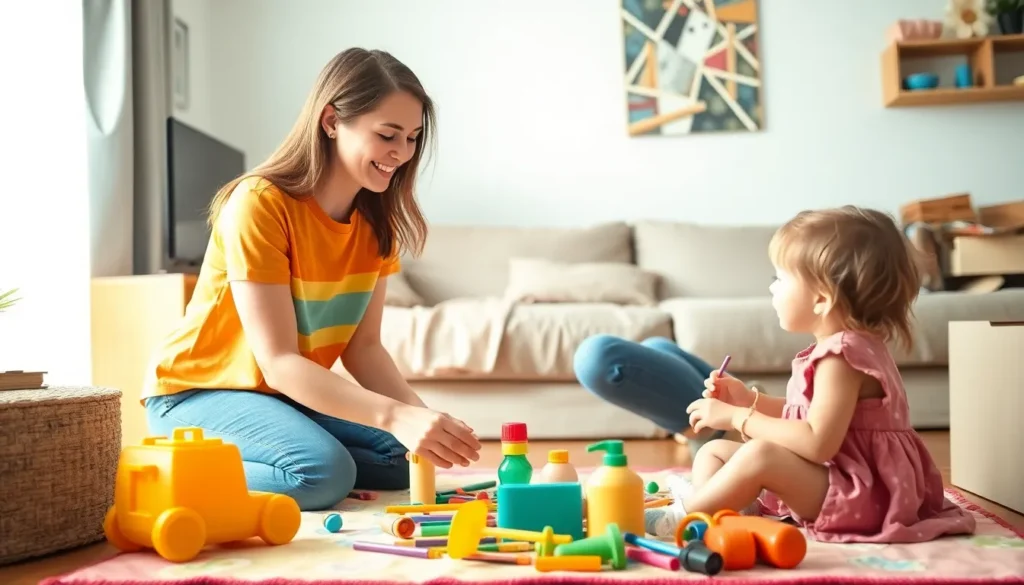Table of Contents
ToggleBabysitting can feel like a high-stakes game of chess, where every move counts and the pawns are pint-sized tornadoes of energy. Whether it’s a giggle-filled evening or a potential disaster waiting to unfold, the right babysitting tips can turn chaos into calm. With a little preparation and a sprinkle of creativity, anyone can become the superhero of playtime.
Essential Babysitting Tips
Effective babysitting requires thoughtful preparation and understanding of children’s needs. These essential tips guide babysitters in creating safe and engaging environments.
Preparing for the Job
Gather relevant information before the babysitting session. Know the family’s expectations and any specific instructions from parents. Bring essential items such as snacks, toys, and first aid kit to ensure readiness. Familiarize yourself with household rules, emergency contacts, and any allergies. Arriving early helps establish trust and allows time for settling in. Set a comfortable space for children, encouraging a welcoming atmosphere. A well-prepared babysitter is more likely to manage unexpected situations with confidence.
Understanding the Children
Focus on building rapport with the children for successful interactions. Establishing a connection encourages open communication and trust. Pay attention to each child’s age, personality, and preferences, as these factors influence behavior. Different activities suit various age groups; simpler games entertain younger children, while older kids may enjoy more complex tasks. Observe body language and emotional cues to respond appropriately. Managing group dynamics fosters cooperation and minimizes conflicts during playtime. Understanding individual needs contributes to a positive babysitting experience.
Safety First

Safety plays a critical role in babysitting. Prioritizing safety ensures a positive experience for both the caregiver and the children.
First Aid Basics
Understanding first aid basics is essential for babysitters. Familiarity with CPR techniques, choking response, and how to treat minor wounds is crucial. They should keep a first aid kit readily accessible, containing items such as bandages, antiseptic wipes, and adhesive tape. Knowing emergency contact numbers guarantees swift communication in case of accidents. It’s advisable to attend a first aid course to boost confidence and readiness. Training equips caregivers to handle unexpected situations with composure.
Creating a Safe Environment
Creating a safe environment requires thorough preparation. Ensuring that sharp objects and hazardous materials are out of reach can prevent accidents. Childproofing areas by using outlet covers and securing heavy furniture minimizes risks. Constant supervision is vital, especially during active play. Designating play areas helps keep children safe and organized. Additionally, discussing house rules with the children fosters awareness of safe behaviors. Establishing clear boundaries promotes a sense of security, allowing the children to feel comfortable.
Engaging Activities
Engaging activities keep children entertained while promoting learning and creativity. Selecting the right activities based on age and interests makes a significant difference.
Age-Appropriate Games
Choosing age-appropriate games enhances children’s enjoyment and ensures they remain engaged. Younger children might enjoy simple games like “Simon Says” or “Duck, Duck, Goose.” These activities encourage physical movement and attention. For older kids, interactive games like charades or board games stimulate critical thinking and teamwork. Incorporating role-playing scenarios helps develop social skills and imagination. Remember, the activities should challenge without overwhelming them. Observing their reactions helps identify what excites them, guiding future choices in games.
Creative Arts and Crafts
Creative arts and crafts activities foster expression and imagination. Providing materials for drawing, painting, or building with clay captivates children’s interest. Simple projects like making greeting cards or nature collages encourage creativity and boost fine motor skills. Offering a variety of supplies allows children to explore their artistic abilities freely. Engaging in group projects promotes collaboration and communication. Encouragement goes a long way in helping them gain confidence in their creative expressions. Tailoring these activities to their preferences enhances overall enjoyment and achievement.
Communication Skills
Effective communication forms the backbone of successful babysitting. Prioritizing clear interactions enhances relationships with both parents and children, ensuring a smooth experience.
Talking to Parents
Understanding parents’ expectations sets the tone for babysitting. Gathering specific details about routines, allergies, and preferences allows for personalized care. Establishing a communication channel helps maintain updates and address concerns promptly. Asking for clarification when instructions seem vague shows attentiveness and commitment. Always express gratitude as a simple thank you fosters goodwill and strengthens trust. Scheduling follow-ups post-sitting enhances the rapport and opens avenues for future opportunities.
Interacting with Children
Building rapport with children encourages positive interactions. Start by greeting them warmly to create an inviting atmosphere. Addressing them by name fosters a sense of connection. Establishing eye contact while speaking promotes engagement and shows attentiveness. Encouragement and acknowledgment of their feelings validate their emotions, enhancing trust. Using clear, age-appropriate language ensures they comprehend instructions easily. Incorporating play into discussions allows for comfort and open dialogue, promoting self-expression and creativity.
Time Management Strategies
Planning activities in advance ensures smoother transitions between tasks with children. Create a schedule that includes time for play, meals, and rest. Prioritize key activities based on the children’s energy levels and preferences.
Set specific time blocks for each activity, allowing flexibility for spontaneous play. Committing to a routine helps children feel secure while enabling babysitters to adapt as needed. For example, a structured timeframe for snacks and downtime can prevent meltdowns.
Utilize timers or visual schedules to keep children engaged. Timers signal activity changes, which also adds an element of fun. Visual schedules, such as picture charts, assist younger children in understanding what comes next.
Be mindful of downtime limitations in the agenda. Short breaks allow for rest, promoting overall satisfaction and reducing fussiness. Planning downtime activities, like reading or quiet games, offers restful moments without monotony.
Remain organized by keeping a checklist of needed supplies for each scheduled activity. Gathering necessary items beforehand minimizes interruptions and maintains flow. For instance, compiling craft supplies in advance helps to avoid last-minute scrambles.
Establishing clear expectations for behavior during each segment fosters respect and smooth participation. Communicate these expectations in a friendly manner, ensuring children understand without feeling overwhelmed.
Remaining positive and patient while managing time expectations sets a cooperative tone. Children often respond well to encouragement and reinforcement, leading to more productive interactions. By allocating time wisely, babysitters create a fun and fulfilling experience for everyone involved.
Mastering the art of babysitting requires a blend of preparation creativity and effective communication. By understanding children’s needs and preferences babysitters can create engaging environments that foster trust and enjoyment. Safety remains a top priority ensuring that both children and caregivers feel secure.
Utilizing time management strategies and establishing clear boundaries helps maintain a structured yet fun atmosphere. With a positive attitude and a willingness to adapt babysitters can turn challenges into memorable experiences. Embracing these tips not only enhances the babysitting journey but also builds lasting relationships with both children and their families.







